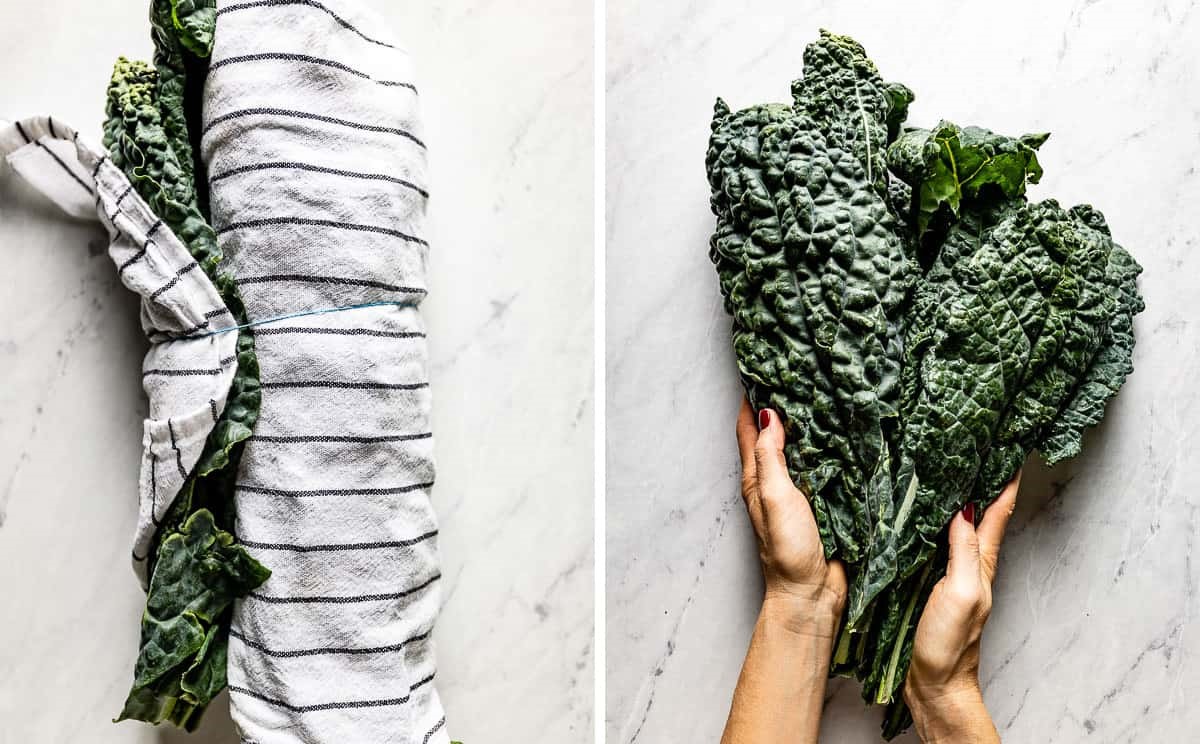Home>Food and Cooking>How To Store Kale


Food and Cooking
How To Store Kale
Published: February 29, 2024
Learn the best ways to store kale to keep it fresh and flavorful. Get expert tips and techniques for food and cooking. Discover how to store kale properly!
(Many of the links in this article redirect to a specific reviewed product. Your purchase of these products through affiliate links helps to generate commission for Noodls.com, at no extra cost. Learn more)
Table of Contents
Introduction
Kale, with its vibrant green leaves and robust flavor, is a versatile and nutritious leafy green vegetable that has gained immense popularity in the culinary world. Whether you're a seasoned home cook or a novice in the kitchen, understanding the best practices for storing kale is essential for preserving its freshness and maximizing its shelf life. By learning the proper techniques for selecting, preparing, and storing kale, you can ensure that this nutrient-packed superfood remains at its peak quality for an extended period.
In this comprehensive guide, we will delve into the intricacies of kale storage, providing you with valuable insights and practical tips to help you maintain the freshness and flavor of this powerhouse vegetable. From selecting the finest kale to implementing effective storage methods, we will cover every aspect of kale preservation, empowering you to make the most of this nutritious ingredient in your culinary endeavors.
Whether you're a health-conscious individual looking to incorporate more greens into your diet or a culinary enthusiast seeking to elevate your dishes with the vibrant flavors of kale, understanding the nuances of kale storage is paramount. By the end of this guide, you will be equipped with the knowledge and expertise to confidently store kale, ensuring that it remains a staple ingredient in your kitchen, ready to be transformed into delectable dishes that nourish both body and soul.
Read more: How To Store Asparagus
Choosing the Right Kale
When it comes to selecting kale for storage, opting for the freshest and highest quality leaves is paramount. The first step in choosing the right kale is to examine its appearance. Look for vibrant, crisp leaves that are free from wilting, discoloration, or signs of decay. The color of the leaves should be a rich, deep green, indicating optimal freshness.
Additionally, consider the size of the kale leaves. While smaller leaves are generally more tender and milder in flavor, larger leaves can be ideal for heartier dishes and cooking methods that require longer cooking times. Ultimately, the choice between small and large leaves depends on your culinary preferences and the specific recipes you intend to prepare.
Another crucial factor to consider when selecting kale is the variety. Common types of kale include curly kale, lacinato (also known as dinosaur kale), and red Russian kale. Each variety boasts its own unique flavor profile and texture, offering versatility in culinary applications. Whether you prefer the robust and earthy notes of curly kale or the slightly sweeter taste of lacinato kale, choosing the right variety is essential for achieving the desired flavor and texture in your dishes.
Furthermore, it's important to source organic kale whenever possible to minimize exposure to pesticides and other harmful chemicals. Organic kale is cultivated without synthetic pesticides and fertilizers, making it a healthier and more environmentally friendly choice.
When purchasing kale, whether from a grocery store, farmers' market, or local farm, take the time to inspect the leaves and assess their overall quality. By being discerning in your selection, you can ensure that the kale you bring home is of the highest caliber, setting the stage for successful storage and culinary endeavors.
In summary, choosing the right kale involves assessing its appearance, size, variety, and sourcing. By prioritizing freshness, vibrant color, and organic options, you can lay the foundation for optimal kale storage and culinary excellence.
Preparing Kale for Storage
Before embarking on the storage process, it is crucial to prepare kale properly to ensure its longevity and quality. The preparation phase sets the stage for successful storage, preserving the freshness and flavor of this nutrient-dense leafy green. Here's a detailed breakdown of the steps involved in preparing kale for storage:
-
Cleaning the Leaves: Begin by thoroughly rinsing the kale leaves under cold running water. Gently rub the leaves with your fingers to remove any dirt, debris, or pesticide residue. Pay special attention to the crevices and folds of the leaves, ensuring that all surfaces are clean. This initial cleaning step is essential for eliminating impurities that can compromise the kale's shelf life.
-
Drying the Leaves: After washing the kale, it's important to ensure that the leaves are completely dry before proceeding with storage. Excess moisture can accelerate decay and promote the growth of mold and bacteria. Use a salad spinner or pat the leaves dry with paper towels to remove excess water. Alternatively, allow the kale to air dry on a clean kitchen towel or drying rack.
-
Trimming and Removing Stems: Once the kale leaves are clean and dry, trim the tough stems from the bottom of each leaf. The stems can be fibrous and less palatable, especially when consumed raw. By removing the stems, you can enhance the texture and overall eating experience of the kale. Simply hold the base of the stem and strip the leaves away, discarding the stems or reserving them for other culinary uses.
-
Inspecting for Quality: While preparing kale for storage, take the opportunity to inspect the leaves for any signs of damage, wilting, or discoloration. Discard any leaves that appear wilted, yellowed, or have blemishes, as they may indicate spoilage or diminished freshness. By selectively choosing the highest quality leaves for storage, you can maintain the integrity of your kale supply.
By meticulously following these preparatory steps, you can ensure that your kale is primed for optimal storage. The cleaning, drying, trimming, and inspection process sets the foundation for preserving the kale's nutritional value and culinary appeal, paving the way for a seamless transition into the storage phase.
Storing Kale in the Refrigerator
Once the kale is properly prepared, storing it in the refrigerator is the next crucial step in maintaining its freshness and quality. Refrigeration provides the optimal environment for preserving kale, extending its shelf life and ensuring that it remains crisp and flavorful. Here's a detailed guide on the best practices for storing kale in the refrigerator:
-
Storage Container: Transfer the prepared kale leaves into a clean, airtight container or resealable plastic bag. Ensure that the container is dry and free from moisture, as excess dampness can lead to premature wilting and decay. Avoid overcrowding the container, as ample space allows for proper air circulation around the leaves, preventing moisture buildup.
-
Moisture Control: To further safeguard the kale from excess moisture, consider placing a dry paper towel or a clean, dry cloth inside the storage container. This absorbent layer helps to wick away any residual moisture, maintaining the crispness of the leaves. Periodically check the paper towel or cloth and replace it if it becomes damp.
-
Temperature Setting: Store the kale in the refrigerator's crisper drawer, which is designed to maintain higher humidity levels than the rest of the fridge. The increased humidity helps to prevent the kale from drying out while still allowing for adequate airflow. If your refrigerator lacks a designated crisper drawer, store the kale in the main compartment, ensuring that it is not exposed to direct airflow from the vents.
-
Optimal Placement: Position the storage container of kale away from ethylene-producing fruits and vegetables, such as apples, bananas, and tomatoes. Ethylene is a natural plant hormone that can accelerate the ripening and deterioration of nearby produce. By isolating the kale from ethylene-emitting items, you can prolong its shelf life and preserve its quality.
-
Regular Inspection: Periodically check the kale for any signs of wilting, moisture buildup, or spoilage. Remove any leaves that show indications of decay to prevent the spread of deterioration to the rest of the batch. By staying vigilant and promptly addressing any issues, you can maintain the freshness of the stored kale.
By adhering to these guidelines, you can effectively store kale in the refrigerator, safeguarding its nutritional potency and culinary versatility. Proper refrigeration not only prolongs the shelf life of kale but also ensures that it remains readily accessible for a myriad of culinary applications, from vibrant salads to hearty soups and stir-fries.
Freezing Kale
Freezing kale is a convenient method for preserving this nutrient-rich leafy green for extended periods, allowing you to enjoy its benefits long after the harvest season. Whether you have an abundant supply of fresh kale or simply want to stock up for future use, freezing provides a practical solution for maintaining the quality and flavor of this versatile vegetable. Here's a comprehensive guide on how to freeze kale effectively:
Read more: How To Store Bacon Grease
Blanching Process
Before freezing kale, it is essential to blanch the leaves to halt the enzymatic activity that can lead to deterioration over time. The blanching process involves briefly immersing the kale in boiling water, followed by rapid cooling to preserve its color, texture, and nutritional value. To blanch kale, follow these steps:
-
Preparation: Thoroughly clean and dry the kale leaves, removing any tough stems and damaged portions. Fill a large pot with water and bring it to a rapid boil.
-
Blanching: Submerge the kale leaves in the boiling water for approximately 2-3 minutes, ensuring that they are fully immersed. The blanching time may vary based on the size and thickness of the leaves.
-
Cooling: Quickly transfer the blanched kale to a bowl of ice water to halt the cooking process. Allow the leaves to cool for an equivalent duration to the blanching time, ensuring that they are completely chilled.
Draining and Packaging
Once the blanching and cooling process is complete, it's crucial to drain the kale thoroughly to remove excess moisture before freezing. Here's how to proceed:
-
Draining: After cooling, gently pat the kale leaves dry with paper towels or use a salad spinner to remove excess water. Ensuring that the leaves are dry is essential for preventing ice crystals from forming during freezing, which can compromise the texture and flavor.
-
Packaging: Divide the blanched and drained kale into portion-sized quantities, placing them in airtight freezer bags or vacuum-sealed containers. Squeeze out any excess air from the bags before sealing to minimize the risk of freezer burn.
Freezing and Storage
Proper freezing and storage techniques are crucial for maintaining the quality of frozen kale. Follow these steps to ensure optimal results:
-
Labeling: Clearly label the freezer bags or containers with the date of freezing to track the storage duration. Additionally, note the contents and portion size for easy identification.
-
Freezing: Place the packaged kale in the freezer, ensuring that it is positioned flat to facilitate efficient freezing and maximize storage space. Avoid overcrowding the freezer to allow for proper air circulation.
-
Storage Duration: Frozen kale can typically be stored for up to 10-12 months without significant loss of quality. However, for the best flavor and texture, aim to use the frozen kale within 6-8 months.
By following these steps, you can effectively freeze kale, preserving its nutritional benefits and culinary versatility for future use. Whether adding it to smoothies, soups, stews, or casseroles, frozen kale offers a convenient and nutritious addition to a wide range of dishes.
Using Stored Kale
Stored kale can be utilized in a myriad of culinary applications, adding a burst of vibrant flavor, nutritional value, and visual appeal to a diverse range of dishes. Whether you have freshly harvested kale from your garden or carefully preserved bundles from the grocery store, incorporating stored kale into your cooking repertoire opens up a world of creative possibilities. Here's a comprehensive exploration of the various ways to make the most of your stored kale:
Read more: How To Open A Convenience Store
Fresh Salads and Wraps
Stored kale serves as an excellent base for fresh salads and wraps, imparting a hearty texture and robust flavor to these dishes. When using kale in salads, consider massaging the leaves with a drizzle of olive oil and a sprinkle of salt to tenderize them and enhance their palatability. Combine the kale with an assortment of crisp vegetables, fruits, nuts, and seeds for a refreshing and nutrient-packed salad. Alternatively, use large kale leaves as a wholesome substitute for traditional wraps, filling them with an assortment of fillings such as hummus, quinoa, roasted vegetables, and lean proteins for a satisfying and healthful meal.
Nutrient-Rich Smoothies
Incorporating stored kale into smoothies is an excellent way to boost their nutritional content and introduce a vibrant green hue. Blend frozen kale leaves with an assortment of fruits, such as bananas, berries, and mango, along with a liquid base such as almond milk or coconut water for a refreshing and nourishing smoothie. The addition of kale infuses the smoothie with essential vitamins, minerals, and antioxidants, making it an ideal choice for a wholesome breakfast or post-workout refresher.
Flavorful Soups and Stews
Stored kale can elevate the depth of flavor and nutritional profile of soups and stews, adding a hearty and earthy essence to these comforting dishes. Whether preparing a classic minestrone, a hearty lentil soup, or a robust vegetable stew, chopped or torn kale leaves make a nutritious and visually appealing addition. Simply stir the kale into the simmering broth or stew during the final stages of cooking, allowing it to wilt and infuse the dish with its distinctive flavor and nutritional benefits.
Sautéed and Stir-Fried Dishes
When sautéed or stir-fried, stored kale develops a delightful texture and flavor, making it a versatile ingredient for a wide array of savory dishes. Heat a drizzle of olive oil in a skillet, add minced garlic and red pepper flakes for a hint of heat, then toss in chopped kale leaves. Sauté until the kale is tender yet retains a slight crunch, seasoning with salt and pepper to taste. This simple preparation yields a delectable side dish or a flavorful addition to pasta, rice, or grain-based dishes.
Baked and Roasted Preparations
Roasting or baking stored kale transforms it into crispy, flavorful chips or a delectable topping for various dishes. Toss kale leaves with a light coating of olive oil, season with spices such as paprika, garlic powder, or nutritional yeast, then bake until crisp for a nutritious and satisfying snack. Additionally, sprinkle roasted kale over pizzas, casseroles, or grain bowls for a delightful crunch and added nutritional value.
By exploring these diverse culinary avenues, you can unleash the full potential of stored kale, infusing your meals with vibrant flavors, wholesome nutrition, and visual allure. Whether incorporated into salads, smoothies, soups, sautés, or baked dishes, stored kale stands as a versatile and invaluable ingredient, enriching your culinary creations with its distinctive character and healthful properties.












